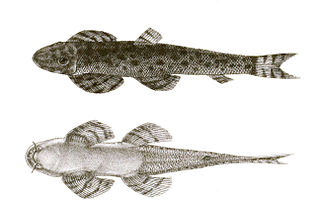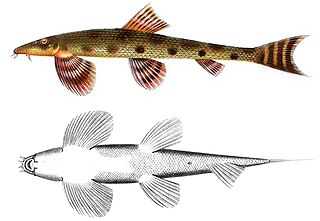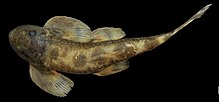
Balitoridae, the hillstream loaches or river loaches, is a family, of small fish from South, Southeast and East Asia. The family includes about 202 species. They are sometimes sold as "lizardfish" or "flossensaugers". Many of the species are popular for aquaria, species in the genus Sewellia are most commonly sold in the aquaria trade. They have a number of similarities with the Cobitidae, their sibling family of "loaches", such as multiple barbels around the mouth. They should not be confused with the loricariids, which look similar but are a family of catfish.

Lepidocephalichthys is a genus of ray-finned fish in the family Cobitidae.
Leptobotia is a genus of fish in the family Botiidae endemic to China.

Beaufortia is a genus of gastromyzontid loaches from China and mainland Southeast Asia.
Beaufortia polylepis is a species of river loach. It is endemic to the Nanpan River in Yunnan, China. It inhabits rocky streams and measures 3.9–4.8 cm (1.5–1.9 in) standard length.

Balitora is a genus of ray-finned fishes in the family Balitoridae endemic to Asia.

Homaloptera is a genus of ray-finned fish in the family Balitoridae.
Erromyzon is a genus of fish in the family Gastromyzontidae endemic to China and Vietnam.
Formosania is a genus of gastromyzontid loaches, most of which are endemic to mainland China. Two species, F. lacustris and F. tengi, are endemic to Taiwan.

Jinshaia is a genus of freshwater ray-finned fishes belonging to the family Balitoridae, the loaches in this family are commonly known as hillstream loaches although this name also refers to the loaches in the family Gastromyzontidae. These loaches are endemic to China.
Liniparhomaloptera is a genus of fish in the family Gastromyzontidae found in China and Vietnam.

Pseudogastromyzon is a genus of ray-finned fish belonging to the family Gastromyzontidae, commonly called the hillstream loaches, although this also refers to the loaches in the family Balitoridae. The loaches in this genus are found in fast-flowing streams and rivers in China.

Vanmanenia is a genus of loaches from China and mainland Southeast Asia.

The Nemacheilidae, or stone loaches, are a family of cypriniform fishes that inhabit stream environments, mostly in Eurasia, with one genus, Afronemacheilus found in Africa. The family includes about 790 species.
Yaoshina is a monospecific genus of freshwater ray-finned fish belonging to the family Gastromyzontidae, commonly called the hillstream loaches, although this also refers to the loaches in the family Balitoridae. The only species in the genus is Yaoshania pachychilus, the panda loach. A loach which is endemic to mountain streams in Jinxiu County, Guangxi in China. This species grows to a length of 5.8 centimetres (2.3 in) SL. This species is monotypic, but it was formerly included in Protomyzon. Juveniles are strikingly coloured in black-and-white, but adults are relatively plain. Y. pachychilus quickly became a popular aquarium fish in the 2010s.

Balitoropsis also known as the lizard loaches is a genus of freshwater ray-finned fishes belonging to the family Balitoridae, the loaches in this family are commonly known as hillstream loaches although this name also refers to the loaches in the family Gastromyzontidae. These loaches are found in mainland Southeast Asia, Sumatra and Borneo.

The Gastromyzontidae are a family of loaches native to China and Southeast Asia, where typically found in streams and rivers with a fast current. The family includes about 137 species in eighteen genera. This family was resurrected by M. Kottelat in his review and revision of the loaches in 2012. They are commonly called hillstream loaches.

Homalopteroides is a genus of freshwater ray-finned fishes belonging to the family Balitoridae, the loaches in this family are commonly known as hillstream loaches although this name also refers to the loaches in the family Gastromyzontidae. These loaches are found in Southeast Asia.

Pseudohomaloptera is a genus of freshwater ray-finned fish belonging to the family Balitoridae, the river or hillstream loaches. The species in this genus are found in eastern Asia.
Bashimyzon is a genus of freshwater ray-finned fishes belonging to the family Gastromyzontidae, a family which shares the common name hillstream loaches with the Balitoridae. These loaches are found in the Guangxi Province of China.












